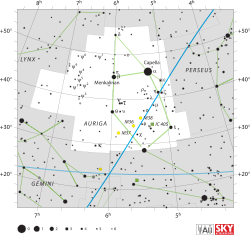Psi2 Aurigae
- For other star systems with this Bayer designation, see Psi Aurigae.

| |
| Observation data Epoch J2000 Equinox J2000 | |
|---|---|
| Constellation | Auriga |
| Right ascension | 06h 39m 19.82634s[1] |
| Declination | +42° 29′ 19.9617″[1] |
| Apparent magnitude (V) | 4.79[2] |
| Characteristics | |
| Spectral type | K3 III[3] or K3 Iab:[4] |
| U−B color index | +1.30[2] |
| B−V color index | +1.23[2] |
| R−I color index | 0.6 |
| Astrometry | |
| Radial velocity (Rv) | 16.09 ± 0.19[5] km/s |
| Proper motion (μ) | RA: -0.87[1] mas/yr Dec.: -54.97[1] mas/yr |
| Parallax (π) | 7.84 ± 0.29[1] mas |
| Distance | 420 ± 20 ly (128 ± 5 pc) |
| Details | |
| Radius | 27[6] R☉ |
| Surface gravity (log g) | 2.30[7] cgs |
| Temperature | 4,410[7] K |
| Metallicity [Fe/H] | –0.10[7] dex |
| Rotational velocity (v sin i) | 1.0[8] km/s |
| Other designations | |
Psi2 Aurigae (ψ2 Aur, ψ2 Aurigae) is a star in the constellation Auriga. It is faintly visible to the naked eye with an apparent visual magnitude of 4.79.[2] Based upon parallax measurements, this star is approximately 420 light-years (130 parsecs) away from the Earth. At that distance, the brightness of the star is diminished by 0.07 in magnitude from extinction caused by interstellar gas and dust.[5]
Most studies categorized this as a K-type giant star with a stellar classification of K3 III.[3] However, the results of a study published in 2003 list it with a classification of K3 Iab:, which would instead suggest it is a supergiant star.[4][9] The measured angular diameter of this star, after correction for limb darkening, is 1.97 ± 0.02 mas.[10] At the estimated distance of this star,[1] this yields a physical size of about 27 times the radius of the Sun.[6]
References
- 1 2 3 4 5 6 van Leeuwen, Floor (November 2007), "Validation of the new Hipparcos reduction", Astronomy and Astrophysics, 474 (2): 653–664, arXiv:0708.1752v1
 , Bibcode:2007A&A...474..653V, doi:10.1051/0004-6361:20078357. Note: see VizieR catalogue I/311.
, Bibcode:2007A&A...474..653V, doi:10.1051/0004-6361:20078357. Note: see VizieR catalogue I/311. - 1 2 3 4 Johnson, H. L.; et al. (1966), "UBVRIJKL photometry of the bright stars", Communications of the Lunar and Planetary Laboratory, 4 (99): 99, Bibcode:1966CoLPL...4...99J.
- 1 2 Herbig, George H.; Spalding, John F., Jr. (January 1955), "Axial Rotation and Line Broadening in Stars of Spectral Types F0-K5", Astrophysical Journal, 121: 118, Bibcode:1955ApJ...121..118H, doi:10.1086/145969.
- 1 2 Kidger, Mark R.; Martín-Luis, Fabiola (June 2003), "High-Precision Near-Infrared Photometry of a Large Sample of Bright Stars Visible from the Northern Hemisphere", The Astronomical Journal, 125 (6): 3311–3333, Bibcode:2003AJ....125.3311K, doi:10.1086/374996.
- 1 2 Famaey, B.; et al. (January 2005), "Local kinematics of K and M giants from CORAVEL/Hipparcos/Tycho-2 data. Revisiting the concept of superclusters", Astronomy and Astrophysics, 430 (1): 165–186, arXiv:astro-ph/0409579
 , Bibcode:2005A&A...430..165F, doi:10.1051/0004-6361:20041272.
, Bibcode:2005A&A...430..165F, doi:10.1051/0004-6361:20041272. - 1 2 Lang, Kenneth R. (2006), Astrophysical formulae, Astronomy and astrophysics library, 1 (3rd ed.), Birkhäuser, ISBN 3-540-29692-1. The radius (R*) is given by:
- 1 2 3 McWilliam, Andrew (December 1990), "High-resolution spectroscopic survey of 671 GK giants. I - Stellar atmosphere parameters and abundances", Astrophysical Journal Supplement Series, 74: 1075–1128, Bibcode:1990ApJS...74.1075M, doi:10.1086/191527.
- ↑ De Medeiros, J. R.; et al. (November 2000), "Rotation and lithium in single giant stars", Astronomy and Astrophysics, 363: 239–243, arXiv:astro-ph/0010273
 , Bibcode:2000A&A...363..239D.
, Bibcode:2000A&A...363..239D. - 1 2 "50 Aur -- Star in double system", SIMBAD Astronomical Database, Centre de Données astronomiques de Strasbourg, retrieved 24 March 2016
- ↑ Richichi, A.; Percheron, I.; Khristoforova, M. (February 2005), "CHARM2: An updated Catalog of High Angular Resolution Measurements", Astronomy and Astrophysics, 431 (2): 773–777, Bibcode:2005A&A...431..773R, doi:10.1051/0004-6361:20042039.